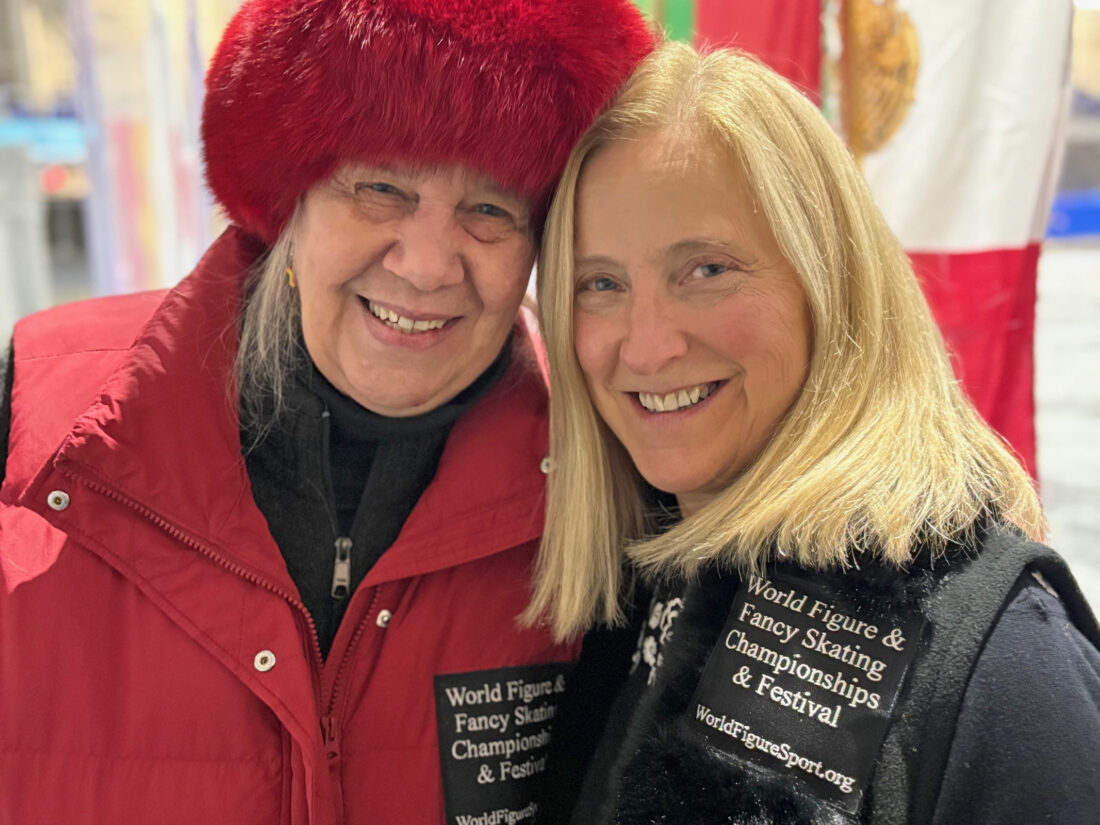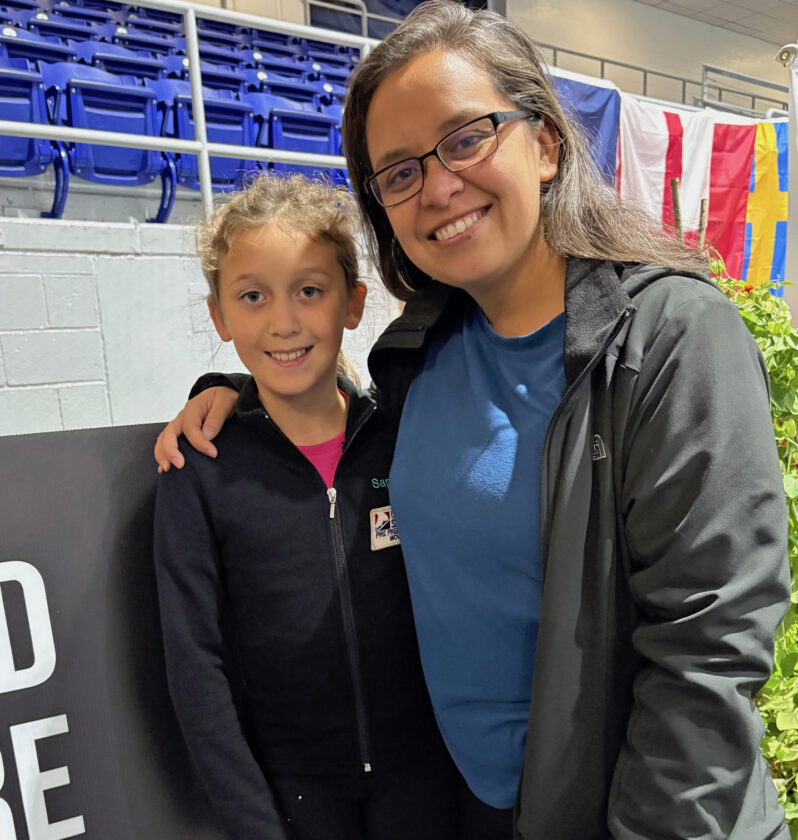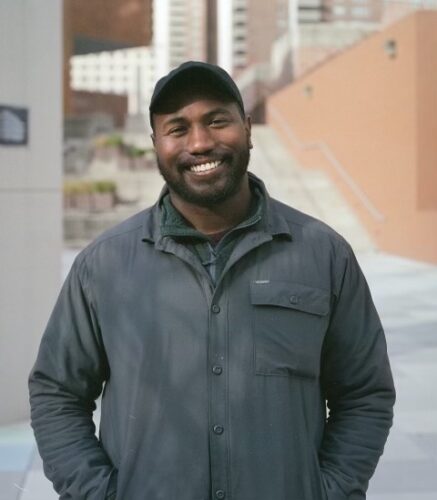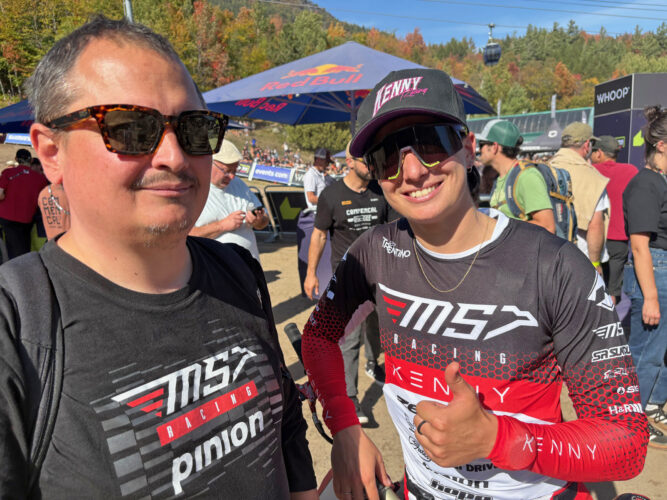ON THE SCENE: The other ‘Miracle on Ice’

Bibi Zillmer-Moritz and fellow skating judge Alicia Walter (Provided photo by Naj Wikoff)
The other “Miracle on Ice” is the impact that Sonja Henie had not just on the United States during the 1932 Winter Olympics, but through the media, on people the world over.
In Lake Placid, the then European phenom took our country by storm, lifting the spirits of so many beaten down by the Great Depression. Doing so, Henie not only energized the Winter Olympics to such a degree that it survived World War II, but she also launched Lake Placid on a path to become the center for training figure skaters for decades to come.
The 11th Anniversary of the World Figure & Fancy Skating Championships, held on Black Ice, brings us back to the very foundation upon which Henie began her career — figures and fancy skating. No question, Henie delighted people with her spins and other flourishes, yet all that was based on her mastery of creating figures on ice.
Back then, skaters skated on natural ice, which was darker than the white ice common today. That was also true of the ice in rinks, as the surface below the ice was sand or cement, resulting in a darker ice, and thus the figures the skaters created were far more apparent. However, hockey required white ice, particularly for filming, as it made the pucks more visible, allowing them to be better seen by skaters, the public, and viewers through broadcast media. Beginning in Lake Placid, the rinks increasingly needed to be shared with hockey, so ice flooring was painted white.
As a consequence, some of the magic of skating figures was lost because creating them on white ice made them invisible to spectators. In time, figures, which were once a significant component of a figure skating competition, were dropped, leaving only the short and free style programs, with jumps and spins, gaining increasing importance. The use of eight and three turns was also lost, which demonstrated a skater’s balance, control, and ability to make precise turns and curves on the ice.

Lindzie Bills and her daughter Saphire (Provided photo by Naj Wikoff)
Eleven years ago, U.S. Olympic figure skater Karen Courtland Kelly and her husband, Canadian Olympic speedskater Patrick Kelly, organized the first World Figure & Fancy Skating Championships held on black ice. Doing so, they rekindled interest in creating patterns and figures on ice, which skaters have been doing at least as far back as the 17th century. Skating dates back to prehistoric times, when people used tied bones on their feet to propel themselves across ice.
In the 13th century, the Dutch developed steel blades, and shortly after, they refined these blades to have sharper edges. They continued to fine-tune the height, thickness, and shape of the blade, resulting in a design similar to what’s used today, though now attached directly to the boot. In 1772, British skater Robert Jones published the first book on how to create an array of figures on ice, the first of many that featured more and more elaborate designs.
Learning how to create figures and patterns on ice became extremely popular, especially as the natural ice allowed skaters to see the results of their efforts. An added attraction is that creating figures and patterns on ice does not require the athleticism of Axel and Salchow jumps and spins, and avoids many of the injuries that can result. A wider range of ages and abilities can learn how to create figures and patterns on ice, which is one reason doing so was so popular in the 18th and 19th centuries.
Goals of the World Figure & Fancy Skating Championships include recognizing skaters who excel at creating specific patterns and figures, encouraging research on and sharing the creation of historic patterns, and stimulating participation by people of all ages and backgrounds in the joys of creating figures and patterns on ice.
“This black ice makes everything pop, and allows us to share the beauty of creating figures and patterns,” said Karen Courtland Kelly. “People are blown away.”
“One of the best things about figures and fancy skating is the control, the beauty, and the creativity of art that the skaters create on the ice,” said Olympian and three-time German champion Bibi Zillmer-Moritz, a member of the World Figure & Fancy Skating Hall of Fame. “I am from the old school. We did figures, and I always loved making them and seeing my own and others’ creativity on ice. I loved the fun of it. Another great thing about figures is that they are achievable and that they are not limited; there are no boundaries up or down or on the ice.”
Zillmer-Moritz noted that in competitive skating, if you can’t push the boundaries of certain jumps, spins, and other features, you can’t move up in the rankings. In contrast, in the sport of figures and fancy skating, there are way more opportunities. Still, in figure and fancy skating competitions, of course, excellence and creativity matter.
“We are looking for different qualities,” said skating judge Alicia Walter. “It could be tracing, centers — where the two circles come together, and there are ones for turns, edge quality, and performance — quality of the actual layout. Our judging is blind. We do not watch the skaters create their shapes and patterns. We only see and judge at the results — what’s on the ice.”
Walter taught skating for over forty years, has a gold medal in figures, and loves the figures, which were a required part of competitions when she was young. Walter has served as a Figure & Fancy Skating Championships’ Chief Referee for five years and, like Karen Courtland Kelly and several others who serve as judges and board members, teaches skaters of all ages how to create figures and patterns on ice.
For multiple-year Figure & Fancy Skating Champion Shephard Clark, the beauty of the sport is not just in the artistry, but in how well skaters from competing nations get along, the many international friendships he’s made over the years, and how international skaters support each other. He wishes that the leaders of many countries currently at odds with each other would emulate the athletes from their countries and work together to address issues of common concern.
“Figure skaters are a global family that loves one another and produces beauty together,” said Clark. “We compete by creating beauty. What an excellent message.”
“It’s a very cool experience being in Lake Placid, where our country’s participation in the Winter Olympics started,” said Lindzie Bills, up from North Carolina with her gifted 10-year-old daughter and figure skating competitor Saphire.
(Naj Wikoff lives in Keene Valley and has been writing his column for the Lake Placid News since 2005.)


